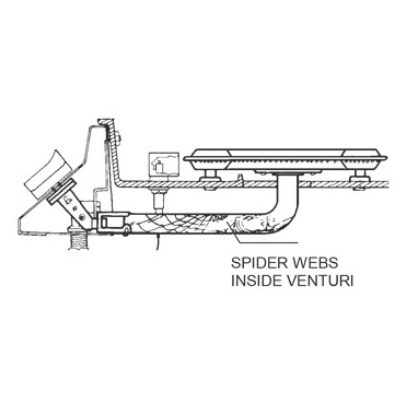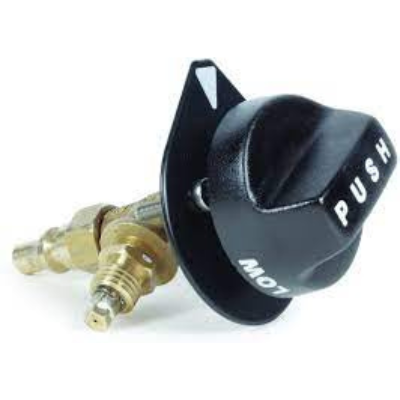Cooking on a gas grill necessitates using heat from a flame. The lower the grill flame, the lower the grill heat, and the longer it will take to prepare your meal. Low flames can be caused by several issues, including a leaking propane tank, broken regulator, blocked orifices, and a tripped OPD device. If turning the knobs clockwise doesn’t raise the flame size, look into some of these possible causes of a low flame. Anyone who uses propane in their barbeque could be affected.
When you just replaced the tank and are cooking to perfection, the next time you open the valve and turn up the knobs, you get these low and guttering flames with little to no heat. What went wrong? Low heat and flames on a gas grill are usually the results of a safety function built into your propane regulator, and we will teach you How to fix low flame on a gas grill in this blog.
Low flame is a common problem that many newbies face while grilling. To fix this problem, close the gas valve, remove the burners, and wash them thoroughly as the fats and other food particles close the small holes of the burners. After cleaning it thoroughly, fix it in its place and let the valve turn on.
Why Does Low Flame Happen?
Because of the safety mechanism in each regulator, low flame concerns are frequent with any propane stove or barbecue. A unique tool is included in regulators to reduce gas flow in the event of a leak. Here’s the concept: If you turned on the propane tank adjacent to a stove with an open flame and your gas appliance leaked you didn’t know about, fuel would spill into the air. The regulator’s safety function can detect and limit an excessive flow of propane. You’re left with a feeble flame and a “poor flow” of propane through the hose.
How to Repair Gas Grill Parts?
Most components for grills built in the last 10 to 20 years can be bought online, but they can be expensive. Ask yourself, “Does this grill fulfill my needs?” before embarking on any home improvement project. If you answered yes, make the necessary repairs. If you answered no, it’s time to shop for a new gas barbecue. Here are some frequent issues and troubleshooting techniques for the many sections of your gas grill.
1. Regulator issue
The most common cause is a clogged regulator. That’s the hose assembly before it’s screwed into the gas tank. This may need to be reset. Follow these instructions to reset the regulator (or check with your manufacturer)

- Turn off the gas in the propane tank.
- Detach the propane tank pipe from the tank.
- Raise the lid of your grill.
- Make sure all of the burner valves are set to high.
- Give it two minutes
- Shut down the valves of all burners.
- Reattach the gas stripe to the propane tank.
- Slowly on the propane tank’s gas.
- Use your standard lighting procedures to light the grill.
If the regulator was stuck, the following steps should have been followed to reset it. You can avoid the regulator sticking again if you constantly switch off your burner valves before turning off the gas at the tank. If you still have a low flame or yellow flame, try again; a malfunctioning regulator may cause the low flame or yellow flame. If it’s broken, it’ll have to be replaced.
2. Fuel leakage
A leak between the tank and the grill is another common cause of low or yellow flame output. To troubleshoot, soak the propane tank valve, connector, and hose in soapy water until the hose connects to the burner assembly on your grill. Look for bubbles in the gas source to indicate tiny leakage; if you have any leaks, repair or replace them immediately for safety reasons.
3. Venturi blockage
Check the grill burner assembly and venturi for obstructions after disconnecting the hose from the tank. Spiders have crawled into the piping and built a web, limiting the quantity of gas that could flow from the reservoir to the grill burners. To do this inspection, follow the manufacturer’s instructions. It’s also possible that the Venturi shutters will need to be modified.

Locate the adjustment screw for the venturi tube. The shutters are opened by unscrewing this screw. Set the grill to low heat and light it. Open the shutters and loosen the venturi screw until the flame is predominantly blue. Gas should be turned off, and the adjustment screw tightened. Allow time for the grill to cool.
4. Control valves
The controlling valves control the fuel flow to the burner. A control valve is located on each burner on your grill. A faulty control valve cannot be repaired; the entire machine should be replaced if necessary. Remove the control valve from your grill and check it before proceeding. Insects love to nest in this area, just like in other parts of your grill.

The orifice is located in the center of the control. The orifice, which controls the flow of fuel, might clog. If it is, clean it out with a tiny wire. Make sure everything is put back together in the same order that it was taken apart. You can’t control the amount of gas going to the burner and run the machine without the orifice.
How to Disconnect a Propane Tank from a Gas Grill?
How to Fix Low Flame on a Gas Grill?
Of course, safety is crucial. But instead of staring at frigid burners, you’d be cooking brats and burgers. Fortunately for you and everyone else waiting for supper, this is a simple problem to solve.
- To begin, switch off the burners on your stove or barbecue and close the gas tank. Before you disconnect the regulator, double-check that everything is turned off.
- Remove the regulator from the tank and set it aside for a few moments. This gives the regulator time to reset.
- Reconnect the regulator to the tank and do a leak test as directed in the instruction manual. Brush the hose and connecting point with a 50/50 soap and water solution. This covers the end where the regulator connects to the tank, the hose connects to the stove, and the valves connect to the manifold’s length.
- Slowly open the tank valve, half-turning it to begin. Turn everything off if you hear a rushing sound or notice “growing” bubbles anywhere you’ve applied the soapy water. You’ve got a leak. Tighten the connections or get a new part to remedy it. Do not use your appliance until the leak has been rectified or the faulty equipment has been replaced.
- You can now try igniting the grill if there are no leaks. To test, light the burners and adjust the heat control knobs.
Fixing Yellow Flame on a Gas Grill?
If none of the preceding recommendations worked, look into these alternative possibilities.
- Clear any dust, grime, or spider webs from the burners and venturi tubes (burner stems). A low or yellow flame can result from several types of obstructions. You can spray straight down into the burners with a garden hose or an air compressor, and you can also spray into the venturi tubes. If you use water, turn the stove upside down for about an hour to let the water drain out before using it again.
- By removing the valve orifices from the venturi tubes and inspecting them, you can ensure they are free of dust and grime. Clean them with a thin wire if necessary.
- Using a different propane tank, test your stove. You may be out of gas.
- Using a different hose and regulator, test your stove. Before igniting the stove, ensure the hose and regulator are leak-free.
Conclusion
When your regulator senses an abnormally high flow of propane, it will restrict the amount of gas discharged. As a result, the flames are faint, and the heat is minimal. In this article, you know how to fix a low flame on the gas grill. Start by resetting the gas regulator on your grill if you have trouble with low flame and temperatures. The propane regulator on all gas grills regulates the flow of gas from the propane tank to the grill, and it is one of the most common reasons a barbeque doesn’t get hot enough.

